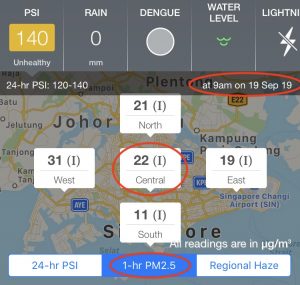What are the goals of ANZA Soccer’s Haze Policy?
ANZA Soccer seeks to protect the health of our players, volunteers, and employees with a haze policy based on best practices and Singapore government recommendations.

Where do we find the NEA figures?
We are using the numbers provided by the NEA, which can be found in the MyENV App or via the NEA Haze website. Pay attention to the time, the zone and index you are looking at (see the screenshot).
Where can I find the MyENV App?
The MyENV App is available for both Android and iPhone.
Why use the NEA’s measurements instead of other services like AQICN or SGAir?
We are aware that other air-quality websites and apps may show other numbers. Because these are all calculated differently, we will only use the NEA measurements, as recommended by the Singapore government. This aligns with the decisions of most schools and sports organizations in Singapore who have developed their own haze policies.
Why has the ANZA Soccer Haze Policy been updated?
Since the last haze episode predating September 2019, the NEA phased out publishing the 3-hr PSI reading, which had been ANZA Soccer’s primary measure for deciding whether to cancel Saturday League matches (using a 3-hr PSI cutoff of 100). The NEA advises that the 1-hr PM2.5 concentration readings are a good indicator of the current air quality and can be used as a guide to adjust one’s immediate activities.
Please note that NEA health advisories are based on the forecasted PSI for the next 24-hours (not the historical 24-hr reading) and there are currently few studies on the health effects of short-term exposure to PM2.5 concentration levels.
How are the PM2.5 and PSI measurements related, and how do they affect ANZA Soccer’s Haze Policy?
During episodes of haze, PM2.5 (particulate matter that is less than or equal to 2.5 micrometres in diameter) is the predominant air pollutant of those used to calculate the PSI (Pollutant Standards Index). When PM2.5 concentrations average 55 μg/m3 over a 24-hour period, the conversion of such PM2.5 concentration to a PSI reading would result in a PSI level of 100.
On this basis, ANZA Soccer has set our hurdle for the 1-hr PM2.5 reading at 55 μg/m3, maintaining consistency with our former haze policy based on a 3-hr PSI of 100. A “Normal” 1-hr PM2.5 reading ≤ 55 μg/m3 corresponds with a “Good/Moderate” PSI-level of ≤ 100, whereas once above 55 μg/m3 for the 1-hr PM2.5 and 100 for the PSI, these descriptors are changed to “Elevated” and “Unhealthy” respectively on the NEA haze matrices.
My child is uncomfortable and/or has a health condition that means he/she should not play even at lower levels of haze than the cutoff. What should I do?
You should feel comfortable removing your child from play. We recognize that different children have different needs, and that different parents have different comfort levels around the haze issue. If you elect to have your child continue to play, please do inform the coach of your concerns and work with him/her to keep your child safe and comfortable.
Why do some schools and sports groups allow play at higher levels of pollutants?
Unfortunately the effects of haze, and especially short-term exposure to haze, are not well understood. Each school and organization makes its own decisions about when and how to suspend activities during a haze episode. For our purposes, we are considering a short-term, highly aerobic activity; we have some flexibility in rescheduling games; our players include many young children; and we enjoy a supportive parent community. For these reasons, we feel comfortable using more a conservative 1-hr PM2.5 cutoff number than some other organizations, which may involve other types of activities, more constraints around scheduling, older participants, and a community that prefers play to continue even at higher pollutant levels.
Why does ANZA Soccer use “Central” as its region when considering the NEA’s readings?
The NEA gives air-quality readings for five regions, which it says “are based on town centres/areas.” ANZA Soccer, playing at The Cage Turf City, appears on the border between the Central and South regions. On a map, Turf City is basically on the edge of the Macritchie reservoir reserve and level (by latitude) with Toa Payoh, both included in the Central region. Like MacRitchie, it is far from the coast and from the industrialized areas in the south of the island, and it is surrounded by greenery, which can help improve air quality. Given these circumstances, the committee has decided that using Central as its region of reference will be most accurate in matching with conditions at the pitches.
What if my AGC feels that the air quality we are experiencing at The Cage is not matching what the numbers say?
The AGC, in consultation with other Committee members at the pitches, will always have the final say on whether to cancel a session even at a lower 1-hr PM2.5 level. This decision may be based on factors such as the actual air quality experienced at The Cage at the time of kick-off and/or a strong trend toward deteriorating air quality in Central or nearby regions.
I want to know more about haze. What are some useful links?

